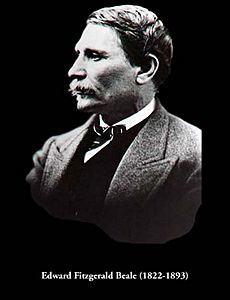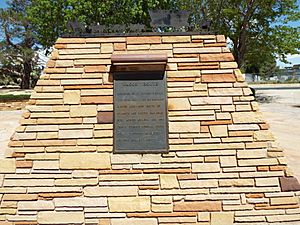Beale's Wagon Road facts for kids

In October 1857, a special journey began across America. It was led by a man named Edward Fitzgerald Beale. His team's big job was to create a new trade route. This route would follow the 35th parallel across the country. It stretched from Fort Smith, Arkansas, all the way to Los Angeles, California.
The wagon trail started in Fort Smith. It then went through what was called the New Mexico Territory. The journey continued to Fort Defiance. From there, Beale's group headed west across northern Arizona. They passed places like Beale Spring near modern Kingman and Sitgreaves Pass.
Next, they crossed the mighty Colorado River. The spot where Beale's team crossed from Arizona into California became known as Beale's Crossing. This was north of today's Needles, California. Beale's path then continued west through Southern California. It went through the Mojave Desert. They followed parts of older trails like the Mojave Trail and the Old Spanish Trail.
The route reached the Mojave River. Here, it crossed the Mormon Road, which led to Los Angeles. After crossing the western Mojave Desert, the trail reached Fort Tejon. It also connected to the Stockton–Los Angeles Road and the El Camino Viejo. These roads helped travelers reach the northern parts of California through the San Joaquin Valley.
Why Beale's Road Was Important
Edward Beale described his new route as the best way to travel west. He said it was the shortest path from the frontier. It cut off about 300 miles compared to other routes. He also noted how flat the land was. His wagons only needed extra help on one short hill. This was amazing for a path that had never been used by wagons before.
The road also had plenty of water. The longest stretch without water was only 20 miles. There were many trees along the way, some larger than any he had seen. The climate was mild because the road mostly went through high areas. It was also a healthy journey. No one in his group needed medical care from start to finish.
Beale pointed out that any road to California had to cross a large desert. His route crossed this desert at its narrowest point. This made the journey much easier. Beale's Wagon Road was very important for a while. However, new ways to travel eventually took its place. In the early 1880s, railroads were built. Later, in 1926, U.S. Route 66 followed much of the same path. Finally, in 1978, Interstate 40 became the main route.
Beale's Advice for the Road
After exploring the road, Edward Beale went to Washington, D.C.. He shared his ideas with members of the Congress and the War Department. He wanted to make the road safer and better for travelers.
He strongly believed that a military fort was needed on the Colorado River. He explained that the Native American tribes living by the river were peaceful farmers. But they were also very numerous. He saw 800 men around his camp one day. He worried that many travelers, especially families, might struggle to cross the wide river. This could be too tempting for the tribes to resist.
Beale also suggested that the route needed bridges and dams. Bridges would make river crossings safer. Dams would help provide a steady supply of water. He asked for $100,000 to pay for these important improvements. This money would help make the road much safer and easier for everyone.


